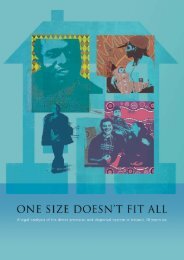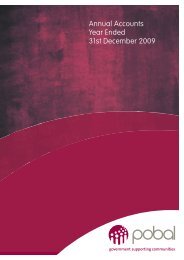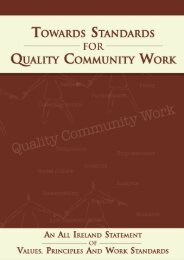Intercultural Education in the Post-Primary School - National Council ...
Intercultural Education in the Post-Primary School - National Council ...
Intercultural Education in the Post-Primary School - National Council ...
You also want an ePaper? Increase the reach of your titles
YUMPU automatically turns print PDFs into web optimized ePapers that Google loves.
4CLASSROOM PLANNINGThe key idea…was to take what we are already do<strong>in</strong>g <strong>in</strong> <strong>the</strong> classroomand take it one step fur<strong>the</strong>r by explor<strong>in</strong>g <strong>the</strong> knowledge, skills andattitudes of <strong>in</strong>tercultural education through <strong>the</strong>se lessons. By see<strong>in</strong>g <strong>the</strong>opportunities that exist <strong>in</strong> our lessons for <strong>in</strong>tercultural perspective, wecan easily make our lessons <strong>in</strong>tercultural…The opportunities for an<strong>in</strong>tercultural perspective are always <strong>in</strong> our lessons but can be easilymissed if we don’t look for <strong>the</strong>m.(The teachers <strong>in</strong>volved <strong>in</strong> <strong>the</strong> Celebrat<strong>in</strong>g Difference: Promot<strong>in</strong>g Equality Project)<strong>Intercultural</strong> education provides benefits toall students, whe<strong>the</strong>r <strong>the</strong>y are members of<strong>the</strong> majority community or members of am<strong>in</strong>ority ethnic group. Although particularissues may emerge <strong>in</strong> classrooms where<strong>the</strong>re are students from m<strong>in</strong>ority ethnicbackgrounds, for example, specificlanguage needs or <strong>the</strong> need to preventdiscrim<strong>in</strong>ation, <strong>the</strong> development of an<strong>in</strong>tercultural classroom environment willbe of value to all students. Irrespective of<strong>the</strong> cultural or ethnic make-up of <strong>the</strong>school environment it will aid <strong>the</strong>irunderstand<strong>in</strong>g of <strong>the</strong> normality of diversityand help <strong>the</strong>m to develop <strong>the</strong>irimag<strong>in</strong>ation, <strong>the</strong>ir critical th<strong>in</strong>k<strong>in</strong>g skills,<strong>the</strong>ir ability to recognise and deal withprejudice and discrim<strong>in</strong>ation, and <strong>the</strong>irsocial skills.This chapter looks at <strong>the</strong> development ofan <strong>in</strong>tercultural classroom. It explores <strong>the</strong>development of an <strong>in</strong>tercultural context <strong>in</strong>• review<strong>in</strong>g <strong>the</strong> classroom environment• build<strong>in</strong>g a co-operative learn<strong>in</strong>genvironment• welcom<strong>in</strong>g a new student• creat<strong>in</strong>g a supportive languageenvironment.REVIEWING THE CLASSROOM ENVIRONMENTAs Chapter 2 identified, <strong>in</strong>terculturaleducation is not conf<strong>in</strong>ed to a s<strong>in</strong>glecurriculum area, or <strong>in</strong>deed to areas with<strong>in</strong><strong>the</strong> ‘formal curriculum’. It is embedded <strong>in</strong><strong>the</strong> practices and dispositions that <strong>in</strong>formboth <strong>the</strong> classroom climate and <strong>the</strong> ‘hiddencurriculum’.The same process which is used <strong>in</strong> plann<strong>in</strong>gfor a school community and which wasdescribed <strong>in</strong> Chapter 3 (<strong>the</strong> review-planimplement-evaluateprocess) can be used forplann<strong>in</strong>g <strong>the</strong> physical and social environmentof <strong>the</strong> classroom as well as lessons.36<strong>Intercultural</strong> <strong>Education</strong> <strong>in</strong> <strong>the</strong> <strong>Post</strong> <strong>Primary</strong> <strong>School</strong>
















